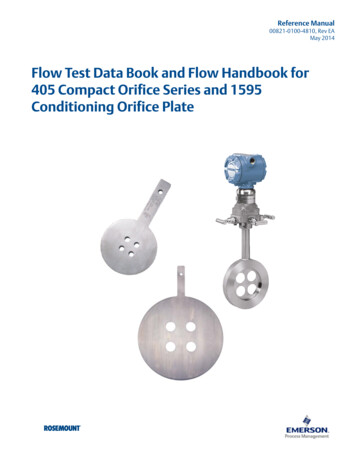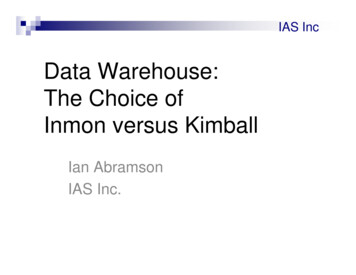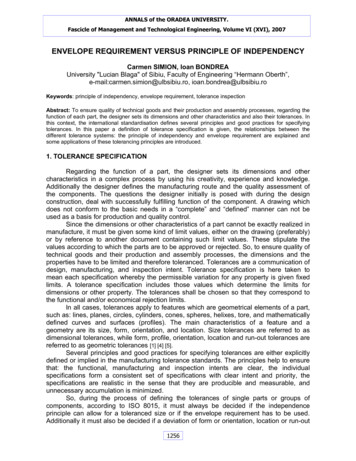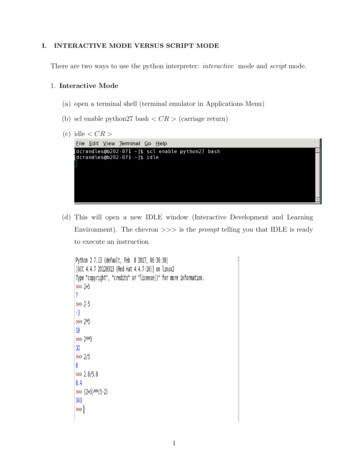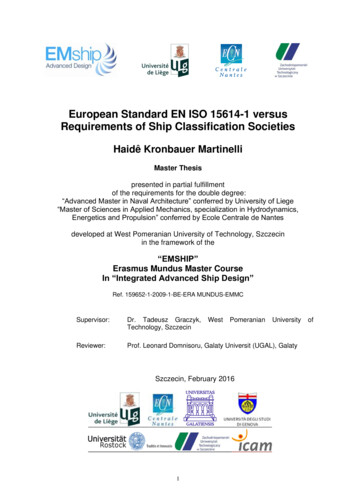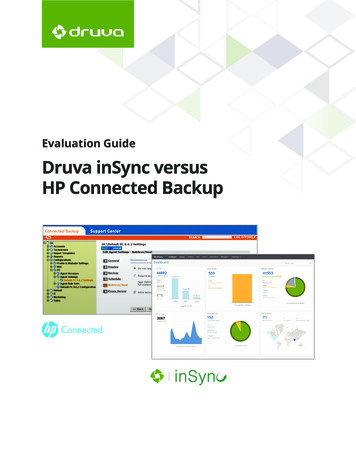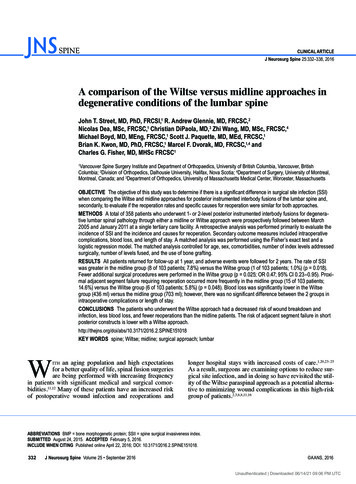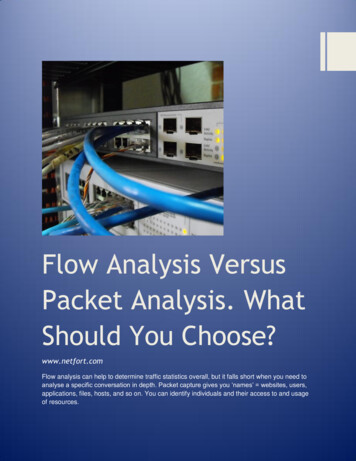
Transcription
Flow Analysis VersusPacket Analysis. WhatShould You Choose?www.netfort.comFlow analysis can help to determine traffic statistics overall, but it falls short when you need toanalyse a specific conversation in depth. Packet capture gives you ‘names’ websites, users,applications, files, hosts, and so on. You can identify individuals and their access to and usageof resources.
Network traffic analysis is a technique used to look at communication patterns on a computer network.“Traffic analysis is the process of capturing and examining network data in order to deduce informationfrom patterns in communication” [1]. In general, the more data that you capture, the more you can inferfrom the traffic. There are two main technologies that you can choose from if you want to performtraffic analysis on your network; flow analysis and packet analysis.What is flow analysis?A flow is a traffic stream with a common set of identifiers. Typically, a flow is defined by traffic that hasthe same source IP, destination IP, protocol, source port, and destination port. If any of these variableschange, then a new flow is defined. For example, when a client is connecting to a server, several flowsmight be created because the client might establish several connections to the server, involving newsource ports. Each one of these connections would be a separate flow. NetFlow, sFlow, IPFIX are allways to collect information about traffic that is traversing a network.NetFlow exports data flow information in UDP datagrams in one of following formatsDevices such as routers or switches along the traffic path can generate flow data, based on the trafficthat is traversing them. The flow data is sent to a flow collector, which then creates reports andstatistics from the flow updates. This process is called flow analysis. The packets sent to a flow collectorare not copies of the actual packets in the traffic flow, as is the case in a SPAN port. The flow analysispackets carry statistical data regarding the flow. Flow-based reporting is a good way to understand whattraffic is traversing the network. Most NetFlow collection applications deployed today use NetFlowversion 5, which tracks the following key fields: Source interfaceSource and destination IP addressLayer 4 protocol (for example, ICMP, TCP, UDP, OSPF, ESP, and so on)Source and destination port number (if the layer 4 protocol is TCP or UDP)Type of service value
NetFlow v9 and Internet Protocol Flow Information Export (IPFIX) are available on some Cisco IntegratedServices Routers (ISRs) and Cisco ASR 1000 Series Aggregation Services Routers (ASR1ks) with NextGeneration Network based Application Recognition (NBAR2) enabled. These device features will allowyou to capture application information but has very limited support in most NetFlow collectors.What is packet analysis?Although flow-based analysis solutions are great, there are some areas where packet capture andanalysis is still needed. Packet analysis is normally associated with SPAN or mirror ports, which areavailable on most managed network switches. “Port mirroring is used on a network switch to send acopy of network packets seen on one switch port (or an entire VLAN) to a network monitoringconnection on another switch port” [2]. Port mirroring on a Cisco Systems switch is generally referred toas Switched Port Analyser (SPAN); some other vendors have other names for it, such as Roving AnalysisPort (RAP) on 3Com switches.Deep packet inspection (DPI) applies to technologies that use packets as a data source and then extractmetadata such as application or website names. In contrast, flow data in most cases does not provideany information about what is contained within packet payloads.For this reason, when analysing an application, it is critical to use packet capture solutions because theylet you see the actual packets involved in client conversations and identify the root cause of an issue.Content-based application recognition, which is based on Deep Packet Inspection, can identify traffic byapplication, even when unusual or dynamic port numbers are used.
Flow Analysis versus Packet Analysis – For Internet MonitoringFlow Analysis ToolsPacket CaptureVendor agnosticNoYesUsername associationNoYesAccurate web domain reportsNoYesResource (URI) namesNoYesProxy reportingNoYesBandwidth usageHTTP header analysisYesNoYesYesPort 80 analysisNoYesSMTP monitoringBitTorrent decodingNoNoYesYesDNS SPAM detectionNoYesWeb client detectionNoYesSecurity/IDSNoYesPassive hostname captureNoYesResource sizes (files)NoYesReal-time dataHistorical dataYesYesYesYesFlow Analysis versus Packet Analysis – For User & Application MonitoringFlow Analysis ToolsNoPacket CaptureYesDeploy at any point in the networkNoYesAccurate application recognitionUsername associationNoNoYesYesDrilldown from application to port numberNoYesDrilldown from application to userNoYesTrue application namesNoYesAccurate web domain reportsNoYesResource (URI) namesNoYesProxy reportingNoYesBandwidth usageYesYesHTTP header analysisNoYesPort 80 analysisNoYesVendor agnostic
SMTP monitoringNoYesBitTorrent decodingNoYesFile activity monitoringNoYesPassive hostname captureNoYesResource sizes (files)NoYesReal-time dataYesYesHistorical dataYesYesFilter bandwidth usage by MAC addressNoYesFilter bandwidth usage by IP addressIP flow count reportingYesYesYesYesFlow Analysis versus Packet Analysis – For Network Security MonitoringFlow Analysis ToolsNoPacket CaptureYesUsername associationNoYesSecurity/IDSTrue application namesNoNoYesYesResource (URI) namesNoYesHTTP header analysisNoYesWeb client detectionNoYesPort 80 analysisNoYesSMTP monitoringBitTorrent decodingNoNoYesYesDNS SPAM detectionNoYesFile activity monitoringNoYesPassive hostname captureNoYesReal-time dataYesYesHistorical dataYesYesIngress and egress IP flows reportsPackets count reportingYesNoYesYesIP flow count reportingYesYesDetect application layer attacksNoYesVendor agnostic
ConclusionFlow analysis can help to determine traffic statistics overall, but it falls short when you need to analyse aspecific conversation in depth. A good example of this is web usage tracking. “NetFlow v5 isn't a goodtracker because nowhere in the list of fields above do we see HTTP header" [3]. The HTTP header is thepart of the application layer payload that actually specifies the website and URL that is being requested.Which analysis method should we use in a monitoring solution?Both! When looking at traffic statistics, flow analysis is sufficient if you only want to see IP addresses andhow much data they are transferring. However, when you want to troubleshoot performance problems,in many cases you need to see the full packet detail.What are the main differences between flow capture and packet capture?1. Flow capture features are normally found on layer 3 type devices like routers. Packet captureuses SPAN or mirror ports which are available on most managed switches.2. Flow capture gives top-level information like IP addresses and traffic volumes. Packet capturealso gives you this and more.3. Flow capture tools can struggle with the activity associated with content delivery networks andapplications that use multiple TCP or UDP ports. If you want accuracy, then packet capture is theway to go.4. Flow capture does not look at payloads contained within packets unless you are using advancedfeatures like Next Generation Network based Application Recognition (NBAR2).5. Packet capture gives you ‘names’ websites, users, applications, files, hosts, and so on. You canidentify individuals and their access to and usage of resources.Try Packet CaptureNetFort LANGuardian is one of the best Deep Packet Inspection solutions on the market. To find outmore, or for your free trial, contact:Web: www.netfort.comE-mail: sales@netfort.comReferences1. http://en.wikipedia.org/wiki/Traffic analysis2. http://en.wikipedia.org/wiki/Port mirroring3. -isnt-web-usage-tracker.html
NetFlow, sFlow, IPFIX are all ways to collect information about traffic that is traversing a network. NetFlow exports data flow information in UDP datagrams in one of following formats Devices such as routers or switches along the

